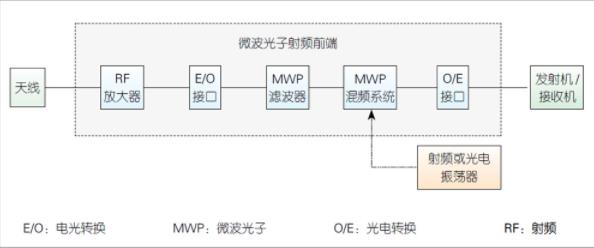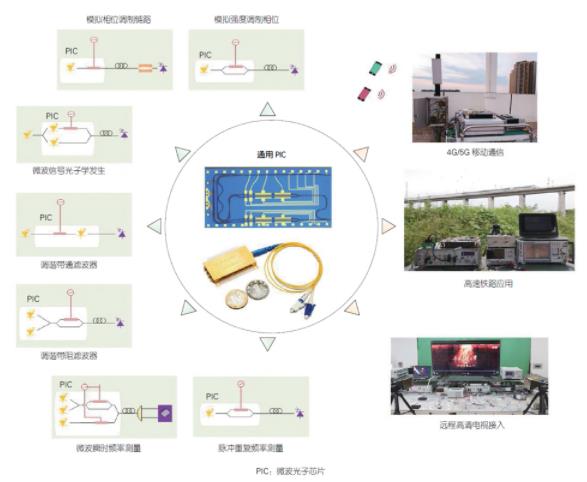About Intelligent Microwave Photon RF,a variety of different frequency bands, communication standards, and wireless services continue to emerge, resulting in more and more obvious diversity and heterogeneity of wireless systems mainly manifested as A variety of different communication systems and standards coexist, such as 5G, which has begun to be commercially available, 4G, and 3G and 2G, which have a certain number of users. A variety of wireless services with different functions coexist, such as wireless LAN, Bluetooth, Beidou and GPS navigation, etc. Different frequency bands coexist, ranging from microwaves at tens of megahertz to millimeter-waves at tens of gigahertz and even terahertz waves. In this context, the wireless system is developing towards the direction of intelligence. On the one hand, it can carry out the seamless compatibility and fusion of broadband multi-band, multi-function, and multi-standard signals. On the other hand, it is flexible and reconfigurable. It can switch and optimize different frequency bands and standard wireless signals according to system functions, service objects, and application scenarios to maximize resource utilization.
Radiofrequency front-end and link are the basic components of the wireless system, which are responsible for the key tasks of wireless signal transmission and transmission. Therefore, the development of Intelligent Microwave Photon RF front-end and link with large bandwidth, multi-band, and reconfigurable characteristics is very important for the further evolution of wireless systems. The existing rf front end and link based on traditional electronic technology have many bottleneck problems, such as high-frequency loss, narrow bandwidth, and low processing speed, which are difficult to meet the needs of intelligent development of the wireless system. In recent years, the rapid rise and maturity of microwave photonics provide new methods and ideas for solving the above problems. The microwave photonic system modulates the high frequency and broadband microwave signals which are difficult to be processed by traditional electronics to the optical domain, and generates, transmits, processes, detects and controls the broadband and high-frequency microwave signal with the help of the inherent advantages such as low loss, large bandwidth and anti-electromagnetic interference of photonics devices or technologies. Microwave photonics technology can effectively alleviate the difficulties faced by traditional electronics technology in processing and transmitting high-frequency bands, large bandwidth, and dynamic time-varying microwave signals. Therefore, the microwave photon intelligent RF front end and link, which can meet the characteristics of broadband, multi-band, and reconfigurable, are the hot topics in the research of microwave RF devices in recent years.

Figure 1. Schematic diagram of microwave photon transceiver front end
The rf front end is located at the front end of the wireless system and is responsible for connecting the transceiver and antenna. It is one of the decisive factors for the performance of the whole system. With the application and deployment of 5G mobile communication and Internet of Things, and to meet the high-performance requirements of the radar in modern electronic warfare, the signals that need to be processed by rf front-end are becoming more and more complex, developing towards intelligent directions such as UHF, multiple modulation formats, multi-band, multi-beam transceiver, and multi-point wireless resource coordination. However, due to the different electronic components used in different frequency bands, it is difficult for the electronic RF front-end to achieve tunable and reconfigurable functions across multiple or even full communication bands by stacking RF modules. Therefore, the broadband microwave photon rf front end with tunable and reconfigurable advantages came into being and developed increasingly.
The main structure of the microwave photon transceiver Intelligent Microwave Photon RF front-end is shown in the figure. Like the traditional electrical RF front end, the microwave photon RF front end (MPRF) needs to complete signal amplification, filtering, local oscillation (LO) signal generation, up and down conversion for transmission and reception, etc. However, MPRF, on the one hand, transforms the RF signal into the optical domain and uses the advantages of the large bandwidth of microwave photon technology to replace electronic devices to achieve signal filtering and mixing and other processing functions, to be compatible with multi-frequency, multi-standard and multi-functional signals. On the other hand, high frequency and tunable LO signals can be generated by photon technology.
At present, the research of reconfigurable MPRF mainly focuses on utilizing the broadband advantages of microwave photon mixing technology to realize the broadband tunable up and down-conversion of the transmitted and received signals, to meet the requirements of multi-band signal compatibility and flexible reconfiguration of intelligent systems. Researchers at Vencore Laboratories in the United States used external modulation to generate the multi-frequency local oscillator of the optical comb for the receiving RF front end. In the experiment, the RADIO frequency signals in the 2 ~ 18 GHz range were down-converted to the 2 GHz intermediate frequency band. Researchers at Nanjing University of Aeronautics and Astronautics have developed a transceiver intelligent microwave photon RF front end in the S-band to Ka-band using external modulation to generate a dual-comb local oscillator. Researchers at the National Laboratory of Optoelectronics in Italy used a mod-locked laser to generate an optical frequency comb-local oscillator, achieving tunable up and down frequency reception and transmission of the signal in a frequency tuning range of 2 to 18 GHz. Researchers from Tsinghua University have proposed a tunable wideband photonic RF front-end scheme based on an optoelectronic oscillator (OEO) with a tunable frequency range covering the X-band to ka-band. In addition, the research group also uses the microwave photon filter based on optical frequency comb and dispersive medium to construct the receiving RF front end, realizing the signal down-conversion and at the same time the if filtering, the frequency coverage is greater than 20 GHz.

Figure
2. Schematic diagram of universal microwave photon chip and its daily
real-time service bearer in indoor and outdoor scenarios
In addition, chip integration of reconfigurable MPRF is a hot research direction recently to provide low-cost, small size, and high-reliability photonic RF front-end solutions. Researchers at Tsinghua University have proposed a silicon-based integrated microwave photon transceiver front-end that generates the optical local oscillator using on-chip out-of-phase modulation. The transmitted signal tuning range is 2 ~ 10 GHz and the received signal frequency coverage is 2 ~ 15 GHz. A team from Southwest Jiaotong University has developed a general-purpose microwave photon integrated chip (PIC), shown here. This chip integrates multiple tunable lasers, modulators, and couplers on a single chip to realize the reconstruction of microwave photonic link structure and signal direction, and can be flexibly configured to perform multiple functions across the three core fields of microwave signal generation, transmission, and processing. It includes remote signal generation, intensity/phase modulated microwave photon transmission link, tunable bandpass/bandstop filter, microwave instantaneous frequency measurement, microwave pulse repetition rate measurement, etc. The chip is directly applied to carry out daily real-time business in indoor and outdoor scenarios. It is directly deployed along the Chengdu - Chongqing (Chengdu Chongqing) high-speed railway line to monitor electromagnetic interference. It is embedded in 4G/5G wireless communication system and 4K HD video access system to support daily real-time business.
The intelligent RF front end and link based on microwave photon technology have the advantages of large bandwidth, reconfiguration, and service transparency, which can fully meet the needs of the intelligent development of the new generation of information technology. A large number of research groups around the world have been working hard in this field and have achieved a series of innovative results. At the same time, the intelligent microwave photon RF front end and the link still need to further solve the cost, power consumption, volume, noise, and other aspects of the problem, to provide the core support for the evolution and change of the new generation of information technology.